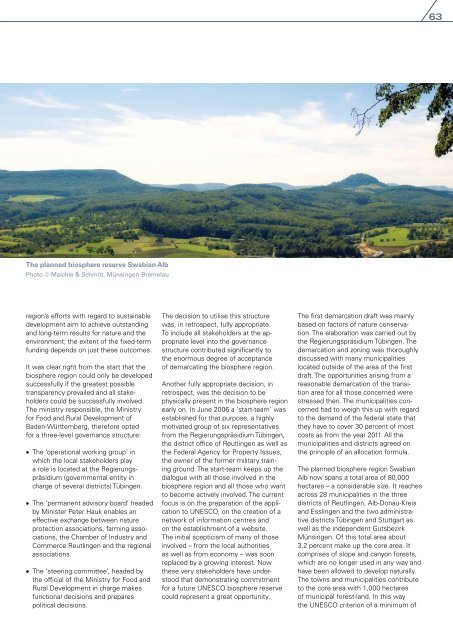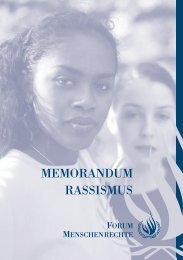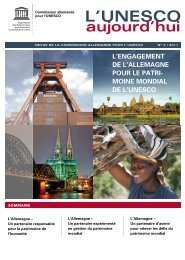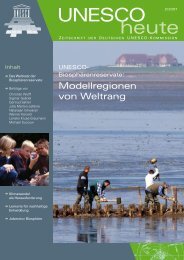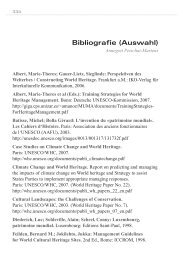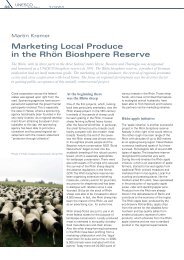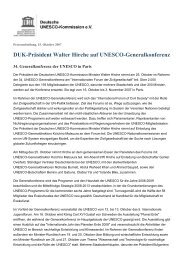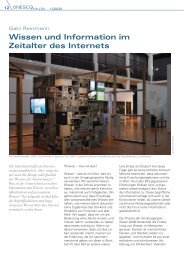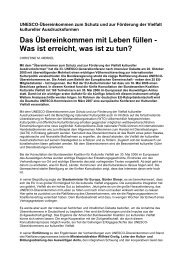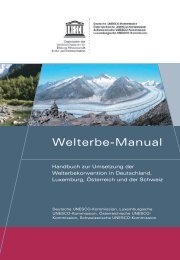Biosphere Reserves - UNESCO Deutschland
Biosphere Reserves - UNESCO Deutschland
Biosphere Reserves - UNESCO Deutschland
You also want an ePaper? Increase the reach of your titles
YUMPU automatically turns print PDFs into web optimized ePapers that Google loves.
The planned biosphere reserve Swabian Alb<br />
Photo © Maichle & Schmitt, Münsingen-Bremelau<br />
region’s efforts with regard to sustainable<br />
development aim to achieve outstanding<br />
and long-term results for nature and the<br />
environment; the extent of the fixed-term<br />
funding depends on just these outcomes.<br />
It was clear right from the start that the<br />
biosphere region could only be developed<br />
successfully if the greatest possible<br />
transparency prevailed and all stakeholders<br />
could be successfully involved.<br />
The ministry responsible, the Ministry<br />
for Food and Rural Development of<br />
Baden-Württemberg, therefore opted<br />
for a three-level governance structure:<br />
• The ‘operational working group’ in<br />
which the local stakeholders play<br />
a role is located at the Regierungspräsidium<br />
(governmental entity in<br />
charge of several districts) Tübingen.<br />
• The ‘permanent advisory board’ headed<br />
by Minister Peter Hauk enables an<br />
effective exchange between nature<br />
protection associations, farming associations,<br />
the Chamber of Industry and<br />
Commerce Reutlingen and the regional<br />
associations.<br />
• The ‘steering committee’, headed by<br />
the official of the Ministry for Food and<br />
Rural Development in charge makes<br />
functional decisions and prepares<br />
political decisions.<br />
The decision to utilise this structure<br />
was, in retrospect, fully appropriate.<br />
To include all stakeholders at the appropriate<br />
level into the governance<br />
structure contributed significantly to<br />
the enormous degree of acceptance<br />
of demarcating the biosphere region.<br />
Another fully appropriate decision, in<br />
retrospect, was the decision to be<br />
physically present in the biosphere region<br />
early on. In June 2006 a ‘start-team’ was<br />
established for that purpose, a highly<br />
motivated group of six representatives<br />
from the Regierungspräsidium Tübingen,<br />
the district office of Reutlingen as well as<br />
the Federal Agency for Property Issues,<br />
the owner of the former military training<br />
ground. The start-team keeps up the<br />
dialogue with all those involved in the<br />
biosphere region and all those who want<br />
to become actively involved. The current<br />
focus is on the preparation of the appli-<br />
cation to <strong>UNESCO</strong>, on the creation of a<br />
network of information centres and<br />
on the establishment of a website.<br />
The initial scepticism of many of those<br />
involved – from the local authorities<br />
as well as from economy – was soon<br />
replaced by a growing interest. Now<br />
these very stakeholders have understood<br />
that demonstrating commitment<br />
for a future <strong>UNESCO</strong> biosphere reserve<br />
could represent a great opportunity.<br />
The first demarcation draft was mainly<br />
based on factors of nature conservation.<br />
The elaboration was carried out by<br />
the Regierungspräsidium Tübingen. The<br />
demarcation and zoning was thoroughly<br />
discussed with many municipalities<br />
located outside of the area of the first<br />
draft. The opportunities arising from a<br />
reasonable demarcation of the transition<br />
area for all those concerned were<br />
stressed then. The municipalities concerned<br />
had to weigh this up with regard<br />
to the demand of the federal state that<br />
they have to cover 30 percent of most<br />
costs as from the year 2011. All the<br />
municipalities and districts agreed on<br />
the principle of an allocation formula.<br />
The planned biosphere region Swabian<br />
Alb now spans a total area of 80,000<br />
hectares – a considerable size. It reaches<br />
across 28 municipalities in the three<br />
districts of Reutlingen, Alb-Donau-Kreis<br />
and Esslingen and the two administrative<br />
districts Tübingen and Stuttgart as<br />
well as the independent Gutsbezirk<br />
Münsingen. Of this total area about<br />
3,2 percent make up the core area. It<br />
comprises of slope and canyon forests,<br />
which are no longer used in any way and<br />
have been allowed to develop naturally.<br />
The towns and municipalities contribute<br />
to the core area with 1,000 hectares<br />
of municipal forest-land. In this way<br />
the <strong>UNESCO</strong> criterion of a minimum of


